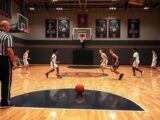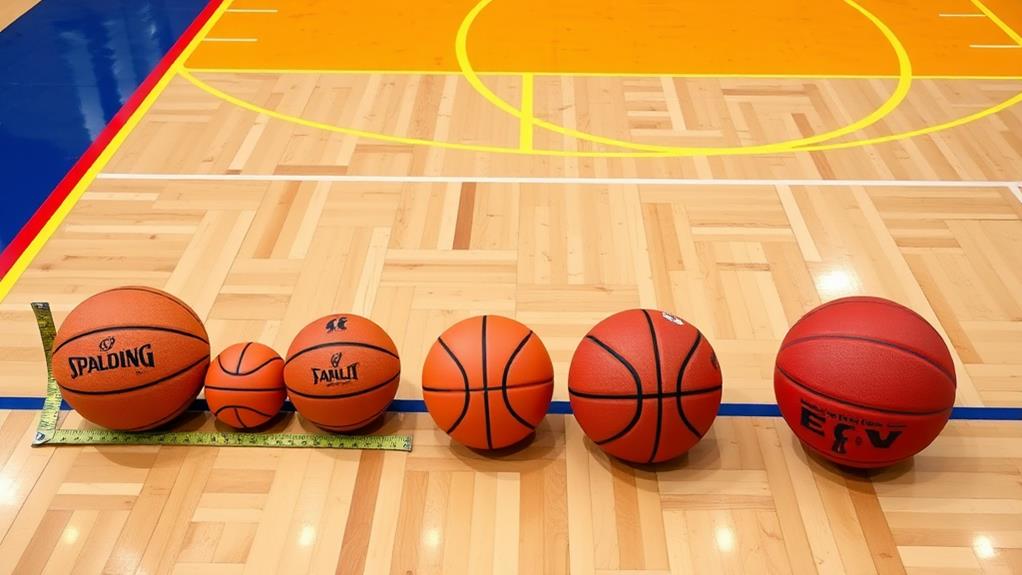
Understanding the Basketball Size Chart: Choosing the Right Ball
November 14, 2024Choosing the right basketball size is essential for your game. Each size impacts your shooting, dribbling, and overall technique. For adult men, a size 7 is standard, while women and boys aged 12 and up should use size 6. Younger players need smaller balls: size 5 for ages 9-11, size 4 for ages 5-8, and size 3 for kids 4 and under. Using the correct size helps prevent bad habits and boosts confidence. Remember to take into account the playing surface and maintain proper inflation for peak performance. Explore more tips to guarantee you select the right ball for your play style!
Importance of the Right Size
When it comes to basketball, using the right size ball is essential for your development. Choosing the correct basketball size isn't just a matter of preference; it directly impacts your shooting, dribbling, and overall technique.
The standard basketball sizes are designed to match players' age and gender—Size 7 (29.5 inches) for men aged 12 and older, Size 6 (28.5 inches) for women aged 9 and older, and Size 5 (27.5 inches) for youth aged 8 to 9. The evolution of basketball equipment, including specialized footwear and advanced materials, has also contributed to how players interact with the ball and the court, enhancing their performance on all levels (evolution of equipment).
Using a ball that's too large or heavy can lead to bad shooting habits, while a smaller ball might hinder your ability to shift to regulation sizes when playing competitively. Properly sized basketballs enhance your confidence and enjoyment, allowing you to focus on mastering essential skills instead of struggling with an ill-fitting ball.
Additionally, being aware of the weight differences is vital; heavier balls can cause issues like shoulder dropping and wrist flicking, especially in young players. So, make sure you're using the right size ball to improve your game and set yourself up for success on the court.
Basketball Size Breakdown
Choosing the right basketball size is essential for players at every stage of their development. The basketball size chart is your go-to reference for selecting the appropriate ball based on age and gender. Proper equipment, like the right basketball, enhances player performance and safety, just as field dimensions and equipment requirements do in soccer.
For men aged 12 and older, a Size 7 basketball with a circumference of 29.5 inches is the official choice, commonly used in high school, college, and professional play. Women aged 12 and older, along with boys aged 9-12, should opt for a Size 6, measuring 28.5 inches.
If you're looking for Youth Basketballs for kids aged 9-11, a Size 5 basketball, at 27.5 inches, is the standard choice for youth leagues. For younger players aged 5 to 8, a Size 4 basketball, measuring 25.5 inches, is perfect for skill development.
Finally, for the little ones aged 4 and under, a Size 3 mini basketball with a 22.5-inch circumference is ideal for fun and introductory play.
With this breakdown, you can confidently choose the right size based on the basketball size chart, ensuring an enjoyable and effective playing experience for every young athlete.
Playing Surface Considerations
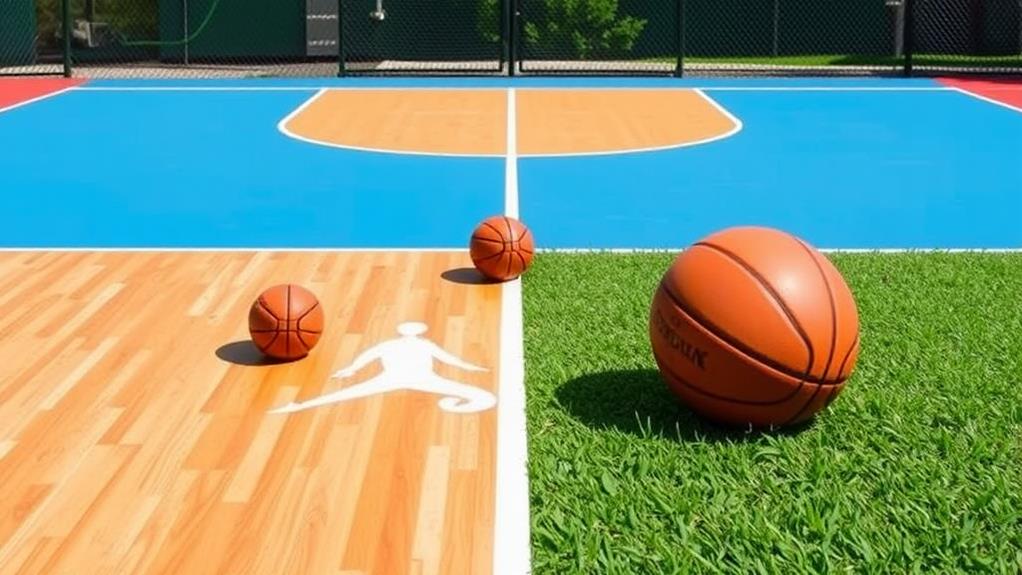
When you're choosing a basketball, the playing surface really matters. Indoor balls, often made of leather or composite, perform best on polished courts, while outdoor balls are built tough for rougher terrain.
The use of lightweight materials in outdoor balls enhances durability and guarantees they can withstand the wear and tear of various surfaces. Understanding these differences helps you pick a ball that enhances your grip and control, no matter where you play.
Indoor vs. Outdoor Balls
Understanding the difference between indoor and outdoor basketballs is crucial for optimizing your game. Indoor basketballs are typically made from leather or composite materials, which enhance performance on smooth surfaces.
On the other hand, outdoor basketballs are constructed from durable rubber, designed to withstand rough terrains and various weather conditions. When you're choosing the right size, consider the surface you'll be playing on.
If you use indoor basketballs outdoors, you may find them wearing out quickly, which can lead to decreased performance and accuracy. The grip and bounce of a ball can considerably impact your shooting, so it's essential to select the appropriate type based on your court.
For players who frequently switch between surfaces, opting for a versatile indoor/outdoor basketball can be a smart choice, offering a balance of durability and performance.
Durability and Performance Factors
How can the right basketball enhance your game? When it comes to durability and performance, selecting a basketball tailored for your playing surface is imperative. Indoor balls are typically crafted from leather or composite materials, designed to deliver peak grip on softer courts.
In contrast, outdoor balls are constructed with rugged rubber, guaranteeing they withstand the wear and tear of rough surfaces.
If you play both indoors and outdoors, consider an indoor/outdoor ball for versatility. However, keep in mind that these may not perform as well as dedicated balls on their respective surfaces.
The right size and weight also play a pivotal role; a well-balanced ball can improve your control and shooting accuracy.
Material choice considerably impacts your game too. Composite balls strike a good balance between durability and grip, making them suitable for various conditions.
Ultimately, using the correct basketball for your intended surface is essential. Choosing the wrong type can lead to decreased performance and diminish your enjoyment of the game.
Surface-Specific Design Features
The design features of a basketball are essential in maximizing your performance on different playing surfaces.
Whether you're hitting the hardwood or the blacktop, choosing the right ball can greatly impact your game. Indoor basketballs typically use leather or composite materials, enhancing grip and control on softer surfaces.
In contrast, outdoor basketballs are built with rugged rubber covers to withstand harsh conditions and rough textures.
Here are some key considerations for selecting the right basketball:
- Material Matters: Leather and composites for indoor; rubber for outdoor.
- Versatility: Indoor/outdoor basketballs can handle both surfaces without losing performance.
- Grip and Control: Indoor balls offer better handling; outdoor balls are more durable.
- Bounce Quality: Specific designs improve bounce based on the surface type.
- Official Size Compliance: Confirm the basketball meets official size standards for competitive play.
Proper Inflation Techniques
When inflating your basketball, always check the recommended pressure printed on the ball to guarantee you don't exceed it.
Proper inflation is key to maintaining ideal shot accuracy and performance, as highlighted in data-driven strategies for improving gameplay.
It's essential to inflate gradually, as over-inflating can damage the ball and void its warranty.
Using the right tools, like a moistened needle, can help you avoid valve damage while maintaining ideal performance on the court.
Recommended Inflation Pressure
Getting the inflation pressure right is crucial for your basketball's performance and longevity. Each official ball comes with a recommended inflation pressure printed on its surface, so make certain to check it.
For a size 7 basketball, the ideal pressure ranges from 8.5 to 9.5 psi, while size 6 balls should be inflated to about 8.0 to 9.0 psi.
Here are some tips to guarantee proper inflation:
- Know the difference: Be aware of psi versus kPa to avoid confusion.
- Moisten the needle: Before you insert it into the valve, this prevents damage.
- Inflate gradually: Increase the pressure slowly to maintain the ball's shape and bounce.
- Avoid exceeding limits: Going beyond the recommended inflation pressure can deform the ball and void warranties.
- Check regularly: Regularly monitor the pressure to keep your ball in peak condition.
Avoiding Over-Inflation Risks
Maintaining the right inflation pressure is essential to your basketball's performance, and avoiding over-inflation is key. Always check the recommended psi printed on your basketball. Exceeding this limit can't only damage the ball but also void any warranty you might have.
Remember, confusion between psi (pounds per square inch) and kPa (kilopascals) can lead to improper inflation, affecting your ball's performance on the court. Over-inflation can cause your basketball to lose its shape and bounce, making it less effective during play.
To avoid this, inflate your ball gradually according to the specified psi. This careful approach helps maintain its integrity and guarantees peak performance when you're shooting hoops.
Additionally, when you're inflating your basketball, it's wise to moisten the needle before inserting it into the valve. This simple step helps prevent valve damage, which can lead to air leaks and further complications.
Inflation Tools and Techniques
To properly inflate your basketball, having the right tools and techniques is essential. Knowing the recommended psi, usually printed on the ball, helps you maintain the correct size and weight.
Remember, over-inflation can deform the ball, affecting its bounce and performance during play. To guarantee a smooth inflation process, follow these simple steps:
- Use a reliable air pump with a pressure gauge.
- Moistening the needle before inserting it into the valve prevents damage.
- Inflate gradually, monitoring the psi closely.
- Familiarize yourself with psi and kPa to avoid confusion.
- Always check the ball's firmness after inflation.
Taking these precautions will help you achieve the ideal inflation level, ensuring your basketball maintains its shape and integrity.
By inflating according to the specified psi, you can enjoy peak performance on the court. Don't forget that the correct size and weight of the ball directly impact your game.
Enhancing Game Performance
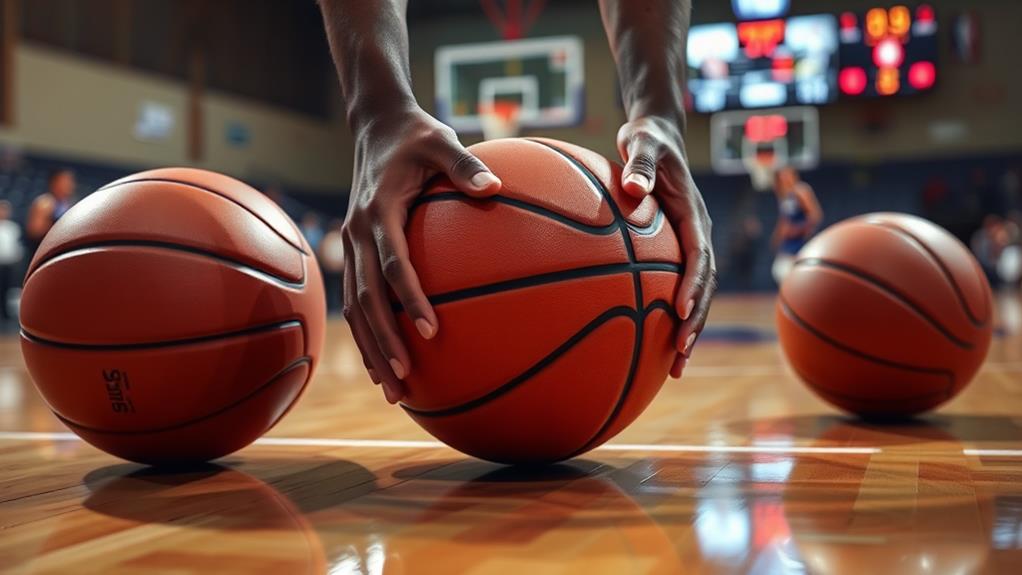
Choosing the right basketball size can greatly enhance your game performance. When you use a basketball that fits your hand and skill level, you'll notice improved grip and control. This means you can focus on honing your shooting technique instead of struggling with a ball that's too heavy or too light.
The evolution of player roles emphasizes the importance of being comfortable with your equipment. For young players, using the correct size is essential; heavier balls can lead to bad habits and hinder their skill development.
Training with the appropriately sized basketball boosts your confidence, making you more willing to take shots and try new moves. As you practice, you'll refine your shooting mechanics, which leads to long-term benefits in your playing style.
Size Recommendations by Age
When choosing a basketball, size matters at every age. Using the right size helps kids develop their skills and feel comfortable with the ball.
In the context of global basketball expansion, making certain that young players have access to appropriate equipment is essential for fostering interest and participation in the sport.
Let's look at the recommendations based on age to guarantee they get the best start in the game.
Age-Appropriate Basketball Sizes
Selecting the right basketball size is essential for developing skills and fostering a love for the game at every age. Knowing the age-appropriate ball size can greatly impact how young players engage with basketball.
Here's a quick guide to help you choose the right ball:
- Size 3: For kids aged 4 and under; it's lightweight and fun!
- Size 4: Ideal for ages 5 to 8; designed for basic skill development.
- Size 5: Best for youth aged 9 to 11; commonly used in organized leagues.
- Size 6: Perfect for boys aged 12 to 14 and for women aged 12 and older; this is the official size for women's high school and collegiate play.
- Size 7: Designed for men aged 15 and older; this is the standard ball size for men's high school, college, and professional play.
Choosing the right size helps guarantee that players can handle the ball effectively, making practice more enjoyable.
Skill Development Considerations
Understanding the right basketball size is essential for skill development as it directly influences how young players engage with the game.
For children ages 4 and under, a size 3 basketball serves as a fun introduction to the sport. As they grow, a size 4 basketball fits youth ages 5 to 8, focusing on basic skills and ball handling in non-competitive settings.
When players reach ages 9 to 11, moving to a size 5 basketball is critical. This size is standard in organized leagues, helping players grasp game rules and develop foundational skills.
As they continue to advance, boys aged 12 to 14 and women aged 12 and older should use a size 6 basketball to prepare them for more competitive play. This size marks a significant change, as it aligns with the official basketball dimensions for women's high school, college, and professional leagues.
Material Preferences
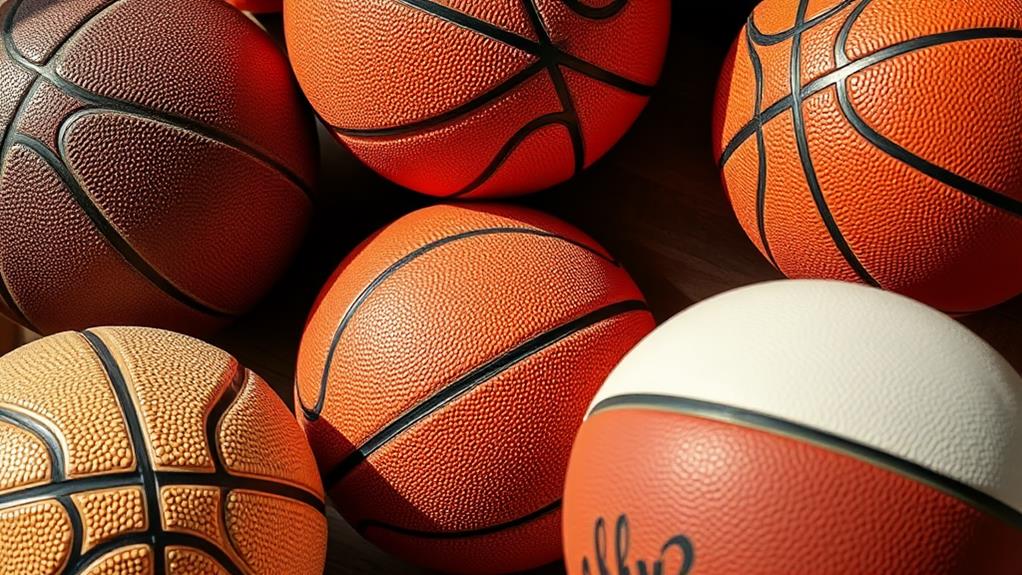
Choosing the right basketball material can greatly impact your playing experience. Each material—rubber, composite leather, and leather—offers unique benefits depending on where and how you play.
For instance, understanding your conditioning needs can inform your choice, as effective conditioning for soccer players emphasizes the importance of selecting equipment that supports your physical demands.
Here's a quick breakdown:
- Rubber: Best for outdoor use, durable against rough surfaces and weather.
- Composite leather: A versatile option that balances durability and grip, perfect for both indoor and outdoor games.
- Leather: Offers superior feel and performance, favored in professional and collegiate play, but demands more care.
- Wilson Airless Gen 1: A recent innovation that doesn't require inflation, enhancing convenience and durability.
- Your playstyle: Consider how you play. Are you hitting the streets or hitting the court?
Understanding these materials helps you choose the right ball for your needs.
If you often play outdoors, a rubber ball is your best bet. For recreational play, try a composite leather ball for its versatility. If you're aiming for high-performance indoor games, go for leather.
Make an informed choice, and your game will thank you!
Developmental Considerations
Developmental considerations play an essential role in youth basketball, as using the right size ball greatly influences skill acquisition and game comprehension. For players aged 5 to 8, a Size 4 basketball (25.5 inches, 14 oz) is important to take into account, as it helps them shift to structured play while developing basic skills. The fundamentals of dribbling, passing, and shooting are vital during this stage, and using an appropriately sized ball supports these skills effectively.
For those aged 9 to 11, a Size 5 basketball (27.5 inches, 17 oz) is recommended, facilitating further skill development and understanding of the game. As young athletes grow, it's important to monitor their performance and adjust the basketball size accordingly. Using a ball that's too large or heavy can hinder their technique, potentially leading to bad habits that are tough to correct.
Also, emphasizing age-appropriate goals and heights will enhance skill development and keep players engaged. Understanding the importance of essential skills and positions can also contribute to their overall game performance.
For players under 4 years old, Size 3 basketballs (22 inches, 10 oz) serve as a fun introduction to the sport. By ensuring players use the right size for women's high and youth leagues, you'll support their development and create a more enjoyable experience on the court.
Common Mistakes in Sizing
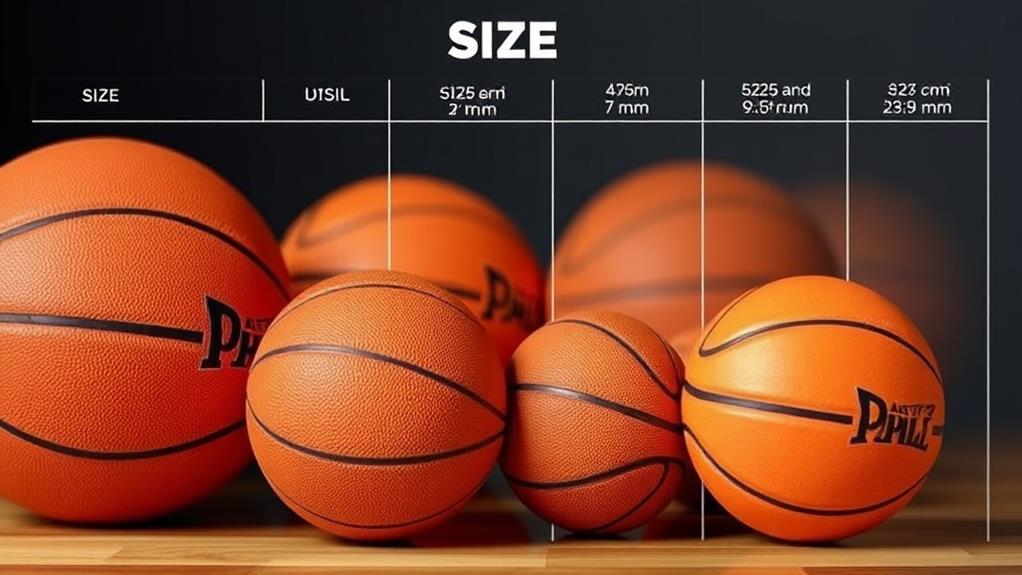
Using the right size basketball can greatly impact a player's experience and skill development. One common mistake is choosing a basketball that's too large. This can hinder your shooting technique and overall enjoyment of the game.
Many youth players mistakenly use a size 7 basketball, designed for ages 15 and older, instead of the appropriate size 5 (ages 9-11) or size 6 balls (ages 12-14). This misuse can stall their development of proper skills. Just as in soccer, where yellow cards serve as significant reminders for maintaining discipline, selecting the right basketball size is vital for fostering growth in young players.
Here are some common sizing mistakes to avoid:
- Overlooking age-appropriate sizes, like size 4 for ages 5-8.
- Ignoring weight differences; a size 3 mini ball weighs only 10 oz compared to the 22 oz size 7 ball.
- Assuming one ball suits all players, regardless of age and skill.
- Neglecting the playing surface; outdoor rubber balls are key for durability.
- Choosing the wrong size ball by not considering specific recommendations for gender, like size for women's high play.
Avoiding these mistakes guarantees a better experience and helps develop essential basketball skills.
Tips for Parents and Coaches
When it comes to fostering young basketball players, parents and coaches play an essential role in selecting the right equipment. Prioritizing the correct basketball size is imperative, especially for youth aged 9 to 11 who should use a Size 5 ball (27.5 inches, 17 oz). Proper sizing enhances shooting technique and overall performance, helping to build players' confidence and enjoyment of the game.
In addition, consistent training is essential for skill development as players grow and adapt to new challenges. It's important to monitor player performance and adjust the ball size as they grow. Shifting from Size 3 (22 inches) for ages 4-8 to Size 6 (28.5 inches) for ages 12-14 can greatly impact their skill development. Engage in discussions about the importance of using age-appropriate equipment to instill patience in young athletes. Emphasize that focusing on skill development is more beneficial than rushing to use official size basketballs too early.
Coaches should implement age-appropriate training formats, like 3-on-3 setups, allowing for skill development rather than competition. This creates a better learning environment.
Continuous education for parents about the importance of correct equipment can combat the trend of using larger balls too soon, which can lead to bad shooting habits and hinder skill acquisition.
Conclusion
Choosing the right basketball size might seem minor, but it's essential for performance and enjoyment on the court. You might think any ball will do, but using the correct size helps improve your skills and boosts confidence. Whether you're a player, parent, or coach, understanding these details will elevate your game. So, don't overlook the importance of size—selecting the right ball can make all the difference in your basketball experience!


